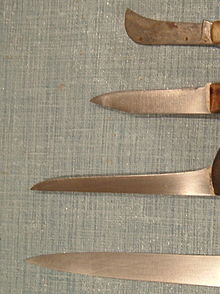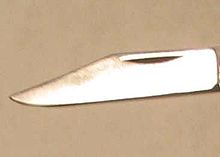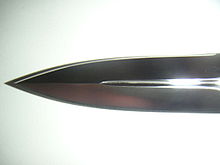- Blade
-
For other uses, see Blade (disambiguation).
 Knife blades
Knife blades
A blade is that portion of a tool, weapon, or machine with a cutting edge and/or a pointed tip that is designed to cut and/or puncture, stab, slash, chop, slice, thrust, or scrape animate or inanimate surfaces or materials. A blade may be made from a flaking stone, such as flint, metal (usually steel), ceramic, or other material.
Contents
Uses
Blades are used for utility purposes (food preparation, craftwork, outdoors sport, etc.) and for combat.
When used for food preparation, the main uses are slicing (cutting by drawing the blade across the object, applying light pressure) and chopping (cutting by pushing the blade through object), with some piercing (using the tip to cut through the surface).[1]
In combat, a blade may be used to slash (i.e. to cut with the edge, generally in a swinging motion), puncture or stab (the blade is plunged into the opponent, starting with the tip and proceeding as the blade enters more deeply), thrown (i.e. by throwing the knife so the point enters the target) or propelled (i.e. a ballistic knife).[2][3]
Blades may be used to scrape, moving the blade sideways across a surface, as in an ink eraser, rather than along or through a surface.
Physics
The ability of a blade to cut arises from the concentration of the force applied to the blade onto a very small area, resulting in a high pressure on the matter to be penetrated.
A serrated blade (a blade which has many small "teeth") takes this further as each individual tooth concentrates the force on a smaller area which helps cut through denser materials. A jagged knife can cut through objects solely with a sliding motion with little pushing force, this is useful, for example, in bread knives. Some bladed weapons (and tools) have curved blades.
As a rule the blade must be made of a substance which is harder than (or as hard as) the material it is intended to cut. If this is not the case the blade will either be unable to cut (as it absorbs all the energy and is damaged) or will wear away very quickly (if it is hard enough to transfer enough of the energy to damage the material). The material must also be tough enough to last (e.g. glass is very hard but it shatters easily and thus is not very effective as a material for a blade).
Heat treatments, which increase hardness for better edge-holding, reduce the material's toughness. A balance must be found between the sharpness and how well it can last. Methods that can circumvent this include differential hardening. This gives an edge that can hold its sharpness and a body that is tough.
Geometry
An ideal blade would come to a perfect edge —not at all rounded— but that says nothing of the angle of that edge. The ideal angle is a function of the material being cut. For example, a tool bit for cutting metal may have nearly a 90° edge; it would probably not even be considered a blade. With very rigid materials such as metal, cutting deep into a piece with a blade would be impossible so deep cutting is done with a saw or grinder which provides kerf through which the cutting device can pass. With less-rigid materials such as a butternut squash, an acute blade prevents the blade from being pinched by the material. When cutting biomaterials such as tomatoes (which tend to have a low elastic modulus but high yield strain), the angle of the blade is less important since the material will bend, but the sharpness of the edge is important because if too much force is required, the material will be squashed rather than cut (or alternatively a serrated blade could be used).
Material
Material for weapon blades has to be selected to achieve a balance between hardness and toughness and the balance is dependent upon the intended use of a blade. In antiquity, the main metal used was copper, then of bronze and later iron. Perhaps the most well known is pattern welding, a technique used for katanas (samurai swords) and blades made to resemble damascus steel blades. This was a very labor-intensive technique - and thus such swords were very expensive.
Techniques may also be employed to make the blade stronger or harder. Copper and bronze can be "work-hardened" by simply hitting the blade with a hammer while it is cold. Blades made of steel with a high enough carbon content (greater than 0.2%) can be heat-treated by heating the steel up to a critical point (most simple carbon alloys become non-magnetic slightly below that point), then quenching it with forced air, oil, or water depending on the steel. Quenching puts an enormous amount of stress on the metal, and often a sword would break into pieces during that step. If the sword survived heat-treating, it would be tempered by heating it to a relatively low temperature for an extended period of time. The tempering process would make it slightly softer, but also tougher and "springier", and thus less likely to break or chip during everyday usage.
Case hardening is a process of increasing the carbon content at the surface of very low carbon steel. It is done by placing the object to be hardened in a sealed container along with carbon-containing material; in antiquity, this material was usually horn or hide. The container would then be heated until it was glowing red, and held at that temperature for a while, based on the size of the part being hardened, allowing carbon to penetrate the steel by a few thousandths of a centimeter. At that point, the object would be dumped out of the container into a water bath to quench it, resulting in a very hard surface, but completely unhardened core. There is very little evidence of this having ever been done to swords except, perhaps, the very earliest of iron blades. Due to the inherent weakness of a sword's cutting edge, coupled with the high-impact stresses of combat, such a thin hardened surface over a soft core would provide very little advantage in terms of edge-holding, other than mild wear resistance.
Another important aspect of many blades are so-called "fullers". Despite popular belief, fullers were not "blood grooves" that facilitated quicker bleeding of the victim and easier removal after insertion. Rather fullers helped to make a blade stronger and more durable at the core by giving it an I beam cross section, thus reducing the amount of steel needed to keep the spine stiff. This was very important in ancient times when high quality steel was more labor intensive to make, smiths would scrape the fuller with a U shaped tool before hardening and reuse the scraps. Modern day fullers are made by positioning a heated blade over a bottom fuller (metalworking), setting a like sized top fuller on the top side of the sword, and hitting the top fuller with a hammer.
The most common materials used nowadays are carbon and stainless steels, though anything that is fairly hard can be used. This has led to exotic blade materials being used in the past, such as obsidian, flint and bone. Joining them now are types such as synthetic sapphire,[4] zirconium dioxide and even very hard plastics.
Dulling
Blades dull with use and abuse. This is particularly true of acute blades and those made of soft materials. Dulling usually occurs due to contact between the blade and a harder substance such as a ceramic, stone or a tougher metal. To a first approximation, a harder material cannot be deformed by a softer material at their interface because the stress on both materials is the same at the interface and so the softer material will yield first. One exception to this is when the highest stress is not at the contact point; this is why a steel paper clip can easily be bent even though the end of the same paper clip could scratch the skin.
Knife blade profiles (Patterns)
Some of the most common shapes are listed below.
(1) A normal blade has a curving edge, and straight back. A dull back lets the wielder use fingers to concentrate force; it also makes the knife heavy and strong for its size. The curve concentrates force on a smaller area, making cutting easier. This knife can chop as well as pick and slice. This is also the best single-edged blade shape for thrusting, as the edge cuts a swath that the entire width of the knife can pass through without the spine having to push aside any material on its path, as a sheepsfoot or drop-point knife would.
(2) A curved, trailing-point knife has a back edge that curves upward. This lets a lightweight knife have a larger curve on its edge. Such a knife is optimized for slicing or slashing. Trailing point blades provide a larger cutting area, or belly, and are common on skinning knives.
(3) A clip-point blade is like a normal blade with the back "clipped" or concavely formed to make the tip thinner and sharper. The back edge of the clip may have a false edge that could be sharpened to make a second edge. The sharp tip is useful as a pick, or for cutting in tight places. If the false edge is sharpened it increases the knife's effectiveness in piercing. The Bowie knife has a clip point blade and clip-points are common on pocket knives and other folding knives.[5]
(4) A drop point blade has a convex curve of the back towards the point. It handles much like the clip-point, though with a stronger point less suitable for piercing. Swiss army pocket knives often have drop-points on their larger blades.
(5) A spear point blade is a symmetrically-shaped blade with a point aligned with the centerline of the blade's long axis. True spear-point blades are double-edged with a central spine, like a dagger or spear head. The spear point is one of the stronger blade point designs in terms of penetration stress, and is found on many thrusting knives such as the dagger. The term spear point is occasionally and confusingly used to describe small single-edged blades without a central spine, such as that of the pen knife, a small folding-blade pocket knife formerly used in sharpening quills for writing. Pen-knife may also nowadays refer to the blade pattern of some of larger pocket knife blades that would otherwise be termed drop-point designs. Some throwing knives may also have spear point blades, but these are commonly made without a spine, being only flat pieces of metal.
(6) A needle point blade has a sharply-tapered acuminated point. It is frequently found on thrusting weapons such as the stiletto, and certain daggers such as the Fairbairn-Sykes fighting knife. Its long, narrow point reduces friction and increases the blade's penetrative capabilities, but is liable to stick in bone and can break if abused. When the needle point is combined with a reinforced 'T' section running the length of the blade's spine, it is called a reinforced tip. One example of a knife with a reinforced tip is the pesh-kabz.
(7) A spey point blade (once used for neutering livestock) has a single, sharp, straight edge that curves strongly upwards at the end to meet a short, dull, straight point from the dull back. With the curved end of the blade being closer to perpendicular to the blade's axis than other knives and lacking a point, making penetration unlikely, spey blades were common on Trapper style pocketknives for skinning fur-bearing animals.[6]
(8) A Kamasu Kissaki, often referred to as a "Americanized tanto" but actually a Japanese design tip which went out of use in the 15th century, has a somewhat chisel-like point that is thick towards the point (being close to the spine) and is thus quite strong. It is superficially similar to the points on most Japanese long and short swords (katana and wakizashi). The traditional Japanese tantō knife uses the blade geometry of (1). The Kamasu Kissaki is often straight but may also be gently curved. The point is actually a second edge on the end of the blade, with a total edge angle of 60 – 80 degrees. Some varieties may have the back edge angled to the point slightly and sharpened for a short distance from the point.
(9) A sheepsfoot blade has a straight edge and a straight dull back that curves towards the edge at the end. It gives the most control, because the dull back edge is made to be held by fingers. Sheepsfoot blades were originally made to trim the hooves of sheep. Their shape bears no similarity to the foot of a sheep.[6]
(10) A Wharncliffe blade is similar in profile to a sheep's foot but the curve of the back edge starts closer to the handle and is more gradual. Its blade is much thicker than a knife of comparable size.[7] Wharncliffes were used by sailors, as the shape of the tip prevented accidental penetration of the work or the user's hand with the sudden motion of a ship.
(11 is the same as 12) An ulu (Inuit woman's knife) knife is a sharpened segment of a circle. This blade type has no point, and has a handle in the middle. It is good for scraping, and sometimes chopping. The semi-circular version appears elsewhere in the world and is called a head knife. It is used in leatherworking both to scrape down leather (reducing thickness), and to make precise, rolling cuts for shapes other than straight lines. {12) is a popular tool for slicing pizzas. One corner is placed at the edge of the pizza and the blade is rolled across in a diameter cut.
Not pictured is the undulating style found on items like the kris or flame-bladed sword. These blades have a distinct recurved blade form and are sharpened on both sides, typically tapering to (or close to) a symmetrical point.
Sword Patterns
See also: Blade geometry and Sword BladeSwords may have either a straight blade or a curved one. A straight sword was thought to be primarily intended for hacking and stabbing, yet recent studies have shown this to be untrue, as many slicing techniques were used. The difference between a hacking cut and a slashing one is essentially the same as the difference between using a butcher's knife and a chef's knife; one forces an edge straight into a material while the other is pulled along the material to get more of a slicing action. Hacking cuts were usually followed by a slicing action, where the sword is drawn backwards to maximize the cut. For more information see Western Martial Arts or kenjutsu.
Some variations included
- the flame blade (undulated blade, for both psychological effect and some tactical advantage of using a non-standard blade: vibrations and easier parry)
- the colichemarde, found in smallsword
The #4 picture showing the drop point silhouette is upside down.
Marks and decoration
 An Anglo-Saxon "broken-back" seax from Sittingbourne in Kent, inscribed in Insular majuscules ☩ BIORHTELM ME ÞORTE ("Biorhtelm made me") and ☩ S[I]GEBEREHT ME AH ("S[i]gebereht owns me").
An Anglo-Saxon "broken-back" seax from Sittingbourne in Kent, inscribed in Insular majuscules ☩ BIORHTELM ME ÞORTE ("Biorhtelm made me") and ☩ S[I]GEBEREHT ME AH ("S[i]gebereht owns me").
Blades are sometimes marked or inscribed, for decorative purposes, or with the mark of either the maker or the owner. Blade decorations are often realized in inlay in some precious metal (gold or silver).[8]
Early blade inscriptions are known from the Bronze Age, a Hittite sword found at Hattusa bears an inscription chiseled into the bronze, stating that the blade was deposited as an offering to the storm-god by king Tuthaliya.[9]
References
- ^ Culinary Institute of America (2007). In the Hands of a Chef: The Professional Chef's Guide to Essential Kitchen Tools. John Wiley and Sons. p. 17. ISBN 9780470080269.
- ^ Echanis, Michael (1977). Knife Self-Defense for Combat. p. 4. ISBN 978-0897500227.
- ^ Echanis, Michael (1979). Knife Throwing for Combat. p. 4. ISBN 978-0897500586.
- ^ English Russia >> Sapphire Knife
- ^ Goddard, Wayne (2000). The Wonder of Knifemaking. Krause. pp. 88–89. ISBN 9780873417983.
- ^ a b Overton, Mac (1990). "Two traditional designs". Blade Magazine 17 (=12): 48–53.
- ^ Rod-neep.co.uk
- ^ Ewart Oakeshott, The Sword in the Age of Chivalry (1964)[1]
- ^ Kristian Kristiansen, Thomas B. Larsson, '0The rise of Bronze Age society: travels, transmissions and transformations (2005)290.
Categories:- Blade weapons
- Cutting tools
Wikimedia Foundation. 2010.





